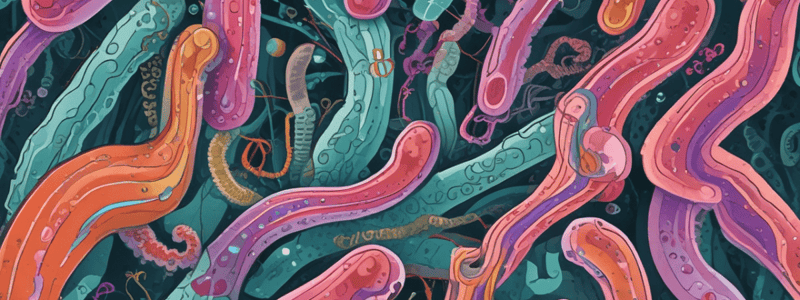Podcast
Questions and Answers
What is a characteristic of intracellular targets of bacterial virulence factors?
What is a characteristic of intracellular targets of bacterial virulence factors?
- They are only produced by Gram-negative bacteria.
- They are always membrane-bound.
- They modulate the host cell metabolism or produce cell death. (correct)
- They are secreted into the extracellular space.
What is an example of a type of toxin produced by endospore-forming bacteria?
What is an example of a type of toxin produced by endospore-forming bacteria?
- Cell-surface active toxin
- Anthrax toxin (correct)
- Pore-forming toxin
- Membrane-damaging toxin
What is a characteristic of AB toxins?
What is a characteristic of AB toxins?
- They are secreted into the extracellular space.
- They only target Gram-positive bacteria.
- They are composed of two subunits. (correct)
- They are always membrane-bound.
What is the result of Shiga toxin activity?
What is the result of Shiga toxin activity?
What is a characteristic of membrane-damaging toxins?
What is a characteristic of membrane-damaging toxins?
What is the result of pore-forming toxin activity?
What is the result of pore-forming toxin activity?
What is a characteristic of cell-surface active toxins?
What is a characteristic of cell-surface active toxins?
What is the result of lipase secreted toxins activity?
What is the result of lipase secreted toxins activity?
What is a characteristic of bacterial endospores?
What is a characteristic of bacterial endospores?
What is the primary function of virulence factors in bacteria?
What is the primary function of virulence factors in bacteria?
Which of the following is NOT a type of virulence factor?
Which of the following is NOT a type of virulence factor?
What is the role of pili in bacterial virulence?
What is the role of pili in bacterial virulence?
Which of the following processes is regulated by quorum-sensing?
Which of the following processes is regulated by quorum-sensing?
What is the function of siderophore secretion in bacterial virulence?
What is the function of siderophore secretion in bacterial virulence?
What is the role of flagella in bacterial virulence?
What is the role of flagella in bacterial virulence?
What is the primary function of bacterial biofilm formation?
What is the primary function of bacterial biofilm formation?
Which of the following is a consequence of bacterial virulence factor regulation?
Which of the following is a consequence of bacterial virulence factor regulation?
What is the role of the two-component system in bacterial virulence?
What is the role of the two-component system in bacterial virulence?
What is the function of the capsule in bacterial virulence?
What is the function of the capsule in bacterial virulence?
What is the primary function of quorum-sensing?
What is the primary function of quorum-sensing?
Which of the following is NOT a function of flagella?
Which of the following is NOT a function of flagella?
What is the result of quorum-sensing in bacterial populations?
What is the result of quorum-sensing in bacterial populations?
What is the result of encapsulation in Streptococcus?
What is the result of encapsulation in Streptococcus?
What is the role of autoinducers in quorum-sensing?
What is the role of autoinducers in quorum-sensing?
What is the primary function of biofilm formation?
What is the primary function of biofilm formation?
Which of the following is a function of flagella in bacterial virulence?
Which of the following is a function of flagella in bacterial virulence?
What is the role of the capsule in Streptococcus?
What is the role of the capsule in Streptococcus?
What is the result of superantigens triggering excessive stimulation of T lymphocytes?
What is the result of superantigens triggering excessive stimulation of T lymphocytes?
What is the function of extracellular matrix toxins?
What is the function of extracellular matrix toxins?
What is the key recognition receptor for Lipid A component?
What is the key recognition receptor for Lipid A component?
What is the effect of LPS on the immune system?
What is the effect of LPS on the immune system?
What is the type of toxin that triggers excessive stimulation of T lymphocytes?
What is the type of toxin that triggers excessive stimulation of T lymphocytes?
What is the function of cell-surface active toxins?
What is the function of cell-surface active toxins?
What is the effect of superantigens on T cells?
What is the effect of superantigens on T cells?
What is the function of hyaluronic acids and collagen?
What is the function of hyaluronic acids and collagen?
What is the result of LPS inducing signaling and immune dysregulation?
What is the result of LPS inducing signaling and immune dysregulation?
What is the primary function of biofilms in relation to bacterial virulence?
What is the primary function of biofilms in relation to bacterial virulence?
Which of the following is a mechanism of transfer of virulence factors?
Which of the following is a mechanism of transfer of virulence factors?
What is the composition of the matrix in biofilms?
What is the composition of the matrix in biofilms?
What is the result of the emergence and dissemination of antimicrobial drug resistance?
What is the result of the emergence and dissemination of antimicrobial drug resistance?
What is the role of bacteriophages in the transfer of virulence factors?
What is the role of bacteriophages in the transfer of virulence factors?
What is the benefit of biofilms in terms of nutrient acquisition?
What is the benefit of biofilms in terms of nutrient acquisition?
Which of the following is NOT a mechanism of transfer of virulence factors?
Which of the following is NOT a mechanism of transfer of virulence factors?
What is the role of transformation in the transfer of virulence factors?
What is the role of transformation in the transfer of virulence factors?
What is the benefit of biofilms in terms of desiccation?
What is the benefit of biofilms in terms of desiccation?
Flashcards
Exotoxins
Exotoxins
Modulate host cell metabolism or cause cell death.
AB toxins
AB toxins
A type of exotoxin with two functional parts.
Type III Secretion System toxins
Type III Secretion System toxins
A type of exotoxin delivered directly into host cells.
Enterotoxin LT
Enterotoxin LT
Signup and view all the flashcards
Shiga toxin
Shiga toxin
Signup and view all the flashcards
Endospores
Endospores
Signup and view all the flashcards
Membrane-Damaging Toxins
Membrane-Damaging Toxins
Signup and view all the flashcards
Pore-forming toxins
Pore-forming toxins
Signup and view all the flashcards
Lipase secreted toxins
Lipase secreted toxins
Signup and view all the flashcards
Virulence Factors
Virulence Factors
Signup and view all the flashcards
Adhesion
Adhesion
Signup and view all the flashcards
Motility
Motility
Signup and view all the flashcards
Efflux pumps
Efflux pumps
Signup and view all the flashcards
Siderophore secretion
Siderophore secretion
Signup and view all the flashcards
Quorum-Sensing
Quorum-Sensing
Signup and view all the flashcards
Autoinducers
Autoinducers
Signup and view all the flashcards
Biofilm Formation
Biofilm Formation
Signup and view all the flashcards
Transformation
Transformation
Signup and view all the flashcards
Transduction
Transduction
Signup and view all the flashcards
Conjugation
Conjugation
Signup and view all the flashcards
Antibiotic secretion
Antibiotic secretion
Signup and view all the flashcards
LPS (endotoxin)
LPS (endotoxin)
Signup and view all the flashcards
Study Notes
Bacterial Virulence
- Exotoxins: modulate host cell metabolism or produce cell death
- AB toxins: a type of exotoxin
- Type III Secretion System toxins: a type of exotoxin
- Enterotoxin LT: a type of exotoxin
- Shiga toxin: a type of exotoxin
Endospores and Toxins
- Bacillus anthracis: produces endospores that can contaminate soil and vegetation
- Endospores: can survive for a long time outside of a host
Membrane-Damaging Toxins
- Pore-forming toxins: dissolve lipids in cell membranes
- Lipase secreted toxins: a type of membrane-damaging toxin
Cell-Surface Active Toxins
- Attached to cell receptors and activate second messenger pathways
- Trigger excessive stimulation of T lymphocytes, resulting in fever, arthritis, dermatitis, and shock
Virulence Factors
- Allow bacteria to colonize niches in hosts and produce disease
- Enable processes such as adhesion, biofilm formation, motility, toxin secretion, immune evasion, and colonization
- Bacterial cell-cell communication: allows bacteria to coordinate behavior and respond to their environment
Surface-Associated Proteins
- Adhesion: allows bacteria to attach to host cells and colonize niches
- Motility: allows bacteria to move towards or away from stimuli
- DNA uptake and transfer: allows bacteria to acquire new genes and traits
- Efflux pumps: allow bacteria to remove toxins and antibiotics from their cells
- Antibiotic secretion: allows bacteria to produce and secrete antibiotics
- Siderophore secretion: allows bacteria to acquire iron from their environment
- LPS (endotoxin): has diverse immunostimulatory and procoagulant effects
Quorum-Sensing
- Regulation of gene expression in response to fluctuations in cell population density
- Mediated by chemical signal molecules (autoinducers)
- Allows bacteria to coordinate behavior and respond to their environment
Biofilm Formation
- Clusters of bacteria attached to a surface and/or to each other and embedded in a self-produced matrix
- Functions: protection from immune system, desiccation, and antibiotics; improved acquisition of nutrients; improved bacterial-bacterial interactions
Transfer of Virulence Factors
- Transformation: bacteria acquire free DNA from the environment, including virulence factor genes
- Transduction: bacteriophages transfer bacterial DNA, including virulence factor genes, from one bacterium to another
- Conjugation: one bacterium can transfer a plasmid, which can contain virulence factor genes, to another bacterium
Studying That Suits You
Use AI to generate personalized quizzes and flashcards to suit your learning preferences.





